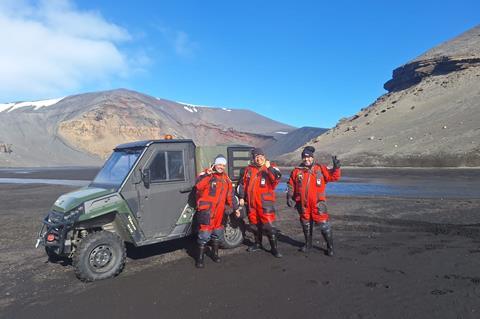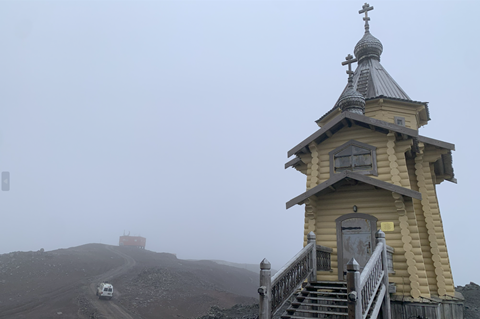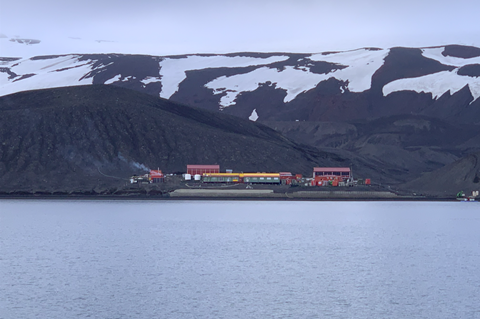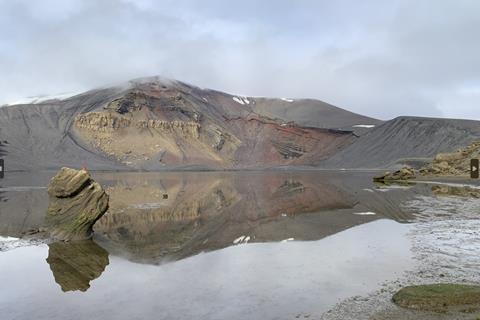AMI Ocean Sustainability Scientific Advisory Group member André Antunes and his colleagues reveal the ups and downs of their latest expedition to Antarctica.

Working with microbiology has its perks. We are writing this short piece directly from the Antarctic as we have embarked on an exciting sampling expedition to some of the most exotic locations on our planet to study their unusual microbes and potential applications.
Long way to the Antarctic
Travelling, living, and working in the Antarctic is quite a challenge! Our team was travelling from different parts of the globe and had to converge on Punta Arenas, Chile’s gateway port to Antarctica - located in Patagonia, and one of the southernmost cities in the World.

We then had to fly on a chartered plane to Antarctica but, given the unstable and unpredictable weather patterns in this polar region, didn’t really get a fixed travel date and had to be on call for updates on our travel window. Delays of several days are quite common and clearance to fly is usually given with very short notice, so you need to be ready to head to the airport shortly after you get the call. The alternative is to get a lift from one of the few available spots on a research ship and cross the Drake Passage, infamous for its very rough seas.
Travel window
Our travel window forced us to travel two days later than originally expected and head to the airport at 2 AM. However, the early morning flight meant that we ended landing in King George’s Island just as the sun was rising across a beautiful clear blue sky. What a glorious first glimpse of Antarctica with an amazing approach and flying around the white-sprinkled black island before landing.

King George’s landing strip, significant size, and the fact that it hosts several scientific bases make it a popular starting point for Antarctic expeditions. The island has multiple facilities which surprisingly include: a small souvenir shop at the Russian base, a minuscule bank, a stunning Orthodox church, and a Christian chapel.
We stayed at the Chilean base Profesor Julio Escudero for a few days until we boarded the Spanish Research Vessel Hespérides A-33. We headed southward, deeper into Antarctica, island-hopping past icebergs, whales, sealions, and penguins, to drop off different teams until we reached our final destination: Deception Island!

Once we reached the island, we were transported to the Spanish Antarctic base Gabriel de Castilla, where we are staying for the rest of the expedition. Despite its military setting, the atmosphere is quite welcoming, and newcomers are quickly integrated into this Antarctic family. Scientists join in the daily life of the base, sharing meals and facilities and helping with cleaning and other small daily chores. The militaries provide essential assistance to the sampling work, keeping track of weather conditions and helping the different teams to safely access remote parts of the island.
Target: Deception Island
Despite the fact that we have opted to focus on extremophiles in a polar region, this does not mean that we are looking for psychrophiles (cold-loving organisms). Our expedition aims to collect samples from several geothermal grounds and fumaroles located across Deception island, a unique marine stratovolcano located in Maritime Antarctica.

The island is famous as it is one of only two active volcanoes in the Antarctic region, and the single one with a marine setting. Accordingly, it has unique polar coastal geothermal grounds, located in intertidal zones, and associated with strong environmental gradients and multiple extreme conditions (most importantly exposure to low and high temperatures: ranging from subzero to up to 100 ºC).
Horseshoe-shaped
Deception Island is horseshoe shaped and has an impressive landscape, with its dark regolith soils attesting its volcanic origin, but also having crimson tainted mountains and yellowish and orange patches. A further highlight is its unique black, red, and green glaciers.
Research on the island has been mostly focused on its geology and its wildlife (the island hosts more than 100,000 breeding pairs of penguins, possibly one of the largest colonies in the world). However, a few studies have looked into the microbiology of some of the geothermal grounds and fumaroles and pointed to the high biotechnological potential of the microbiota associated with these environments.

Despite these, the microbiology of these unusual sites remains under-studied: a wide-scoped sampling, microbiological campaign and thorough study is still missing, partly due to the remote location of the island, unstable weather, tide-dependent access, and the traditionally short sampling windows.
To cover this gap, fresh new samples are currently being collected by our team as part of the 60th ECA (Chilean Antarctic Expedition) and the 37th Spanish Antarctic Campaign; these include a range of water and sediment samples from all currently identified thermal anomaly sites spread across the island. The samples will be used for geochemical characterbiodiversity and bioprospection studies.
Biotechnological potential
Te project (supported by the Instituto Antártico Chileno through the project Regular RT_24-21) will focus on the study on the isolation and characterization of new microbial strains, on the screening, characterization and optimization of expolysaccharide (EPS) production, and assessing the potential use of these bioproducts as food additives.
Microbes produce polysaccharides in their biofilms as a protective sheath to survive against polyextreme factors. Several microbial polysaccharides are already key ingredients in the food industry as additives and others can also be used as novel biomaterials, additives in pharmaceutical or cosmeceutical indsutry or even in waste treatments.
However, there is a continuous search for novel polysaccharides with improved qualities. In this context, the study of geothermal-influenced environments is likely to yield new discoveries, as polyextremophiles from such locations reportedly use different sugars as their carbon source and amino acids as an organic nitrogen source for EPS production.
Moreover, EPSs synthesized by thermophilic microbes are thermostable, thus retaining their emulsifying and rheological properties at the high temperatures at which many food industry processes are performed.
Extraterrestrial analogue
On a different note, Deception Island is also recognized as a relevant analogue to extraterrestrial conditions. Such analogue sites are crucial for Astrobiology, impacting the search for extraterrestrial life and Planetary Protection.

Furthermore, microbial strains isolated from such sites are relevant for space biotechnology as they are likely more resilient to exposure to space-like conditions and might be more suitable for space-based applications and microbial in situ resource utilization (ISRU). This can help increase the sustainability of future space missions and support long-term human presence in space.
André Antunes, State Key Laboratory of Lunar and Planetary Sciences, Macau University of Science and Technology, Taipa, Macao SAR, China; Blue Marble Space Institute of Science, Seattle, WA, United States.
Alexander Gálan, Centro de Investigación de Estudios Avanzados del Maule (CIEAM), Vicerrectoría de Investigación y Postgrado and Departamento de Obras Civiles, Facultad de Ciencias de la Ingeniería, Universidad Católica del Maule, Talca, Chile
Aparna Banerjee, Aparna Banerjee, Instituto de Ciencias Aplicadas, Facultad de Ingeniería, Universidad Autónoma de Chile, Talca, Chile







No comments yet